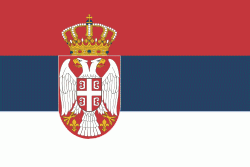Mala Moštanica (Mala Moštanica)
Mala Moštanica is a village located in the municipality of Obrenovac, Belgrade, Serbia. As of 2011 census, it has a population of 1,805 inhabitants.
Mala Moštanica is separated from the Sava river by the Duboko forest. The forest spread in the areas of the neighboring settlements, but the majority is located in Mala Moštanica: Umka and Rucka in the Čukarica municipality on the east, and Barič in the Obrenovac municipality, on the west. Area along the river is a mass wasting zone. Downhill creep is located on the slope above the river, and is one of the largest and most active in Belgrade. Majority is located in Umka, though, where the entire neighborhood of Duboko developed on creeping soil.
City administration adopted a decree by which the 3,83 km2 of the forest will be protected as a natural monument, but the new state law on forests suppressed the decree in 1970, before it took effect, so the forest remained unprotected by the law.
From 2020 to 2022, over 11 ha of the forest was cut. The thick oak forest was cleared, leaving a barren area which was covered by dense black locust grove. Residents and local ecology groups, some specifically founded for monitoring Duboko, protested. State forestry company which administers Duboko, "Srbijašume", claimed that they have done everything by the law, that the forest was in bad shape, and that they already planted seedlings on 5 ha. The company also stated that they will conduct forestation on 1 ha each year, claiming it is optimal given the mass wasting. They also said that the local politicians were notified of the cutting, that the company has an FSC certificate which mens they know what they are doing, and that public calls to stop cutting the forest are unscientific. Citizens also asked for neutral experts to check the forest, and demanded for the "Srbijašume" to place guards, ramps, and cameras, to clean the garbage, arrange the pathways, and arrange the wild locust grove which formed.
Mala Moštanica is separated from the Sava river by the Duboko forest. The forest spread in the areas of the neighboring settlements, but the majority is located in Mala Moštanica: Umka and Rucka in the Čukarica municipality on the east, and Barič in the Obrenovac municipality, on the west. Area along the river is a mass wasting zone. Downhill creep is located on the slope above the river, and is one of the largest and most active in Belgrade. Majority is located in Umka, though, where the entire neighborhood of Duboko developed on creeping soil.
City administration adopted a decree by which the 3,83 km2 of the forest will be protected as a natural monument, but the new state law on forests suppressed the decree in 1970, before it took effect, so the forest remained unprotected by the law.
From 2020 to 2022, over 11 ha of the forest was cut. The thick oak forest was cleared, leaving a barren area which was covered by dense black locust grove. Residents and local ecology groups, some specifically founded for monitoring Duboko, protested. State forestry company which administers Duboko, "Srbijašume", claimed that they have done everything by the law, that the forest was in bad shape, and that they already planted seedlings on 5 ha. The company also stated that they will conduct forestation on 1 ha each year, claiming it is optimal given the mass wasting. They also said that the local politicians were notified of the cutting, that the company has an FSC certificate which mens they know what they are doing, and that public calls to stop cutting the forest are unscientific. Citizens also asked for neutral experts to check the forest, and demanded for the "Srbijašume" to place guards, ramps, and cameras, to clean the garbage, arrange the pathways, and arrange the wild locust grove which formed.
Map - Mala Moštanica (Mala Moštanica)
Map
Country - Serbia
 |
 |
| Flag of Serbia | |
Continuously inhabited since the Paleolithic Age, the territory of modern-day Serbia faced Slavic migrations in the 6th century, establishing several regional states in the early Middle Ages at times recognised as tributaries to the Byzantine, Frankish and Hungarian kingdoms. The Serbian Kingdom obtained recognition by the Holy See and Constantinople in 1217, reaching its territorial apex in 1346 as the Serbian Empire. By the mid-16th century, the Ottomans annexed the entirety of modern-day Serbia; their rule was at times interrupted by the Habsburg Empire, which began expanding towards Central Serbia from the end of the 17th century while maintaining a foothold in Vojvodina. In the early 19th century, the Serbian Revolution established the nation-state as the region's first constitutional monarchy, which subsequently expanded its territory. Following casualties in World War I, and the subsequent unification of the former Habsburg crownland of Vojvodina with Serbia, the country co-founded Yugoslavia with other South Slavic nations, which would exist in various political formations until the Yugoslav Wars of the 1990s. During the breakup of Yugoslavia, Serbia formed a union with Montenegro, which was peacefully dissolved in 2006, restoring Serbia's independence as a sovereign state for the first time since 1918. In 2008, representatives of the Assembly of Kosovo unilaterally declared independence, with mixed responses from the international community while Serbia continues to claim it as part of its own sovereign territory.
Currency / Language
| ISO | Currency | Symbol | Significant figures |
|---|---|---|---|
| RSD | Serbian dinar | дин or din. | 2 |
| ISO | Language |
|---|---|
| BS | Bosnian language |
| HU | Hungarian language |
| SR | Serbian language |















